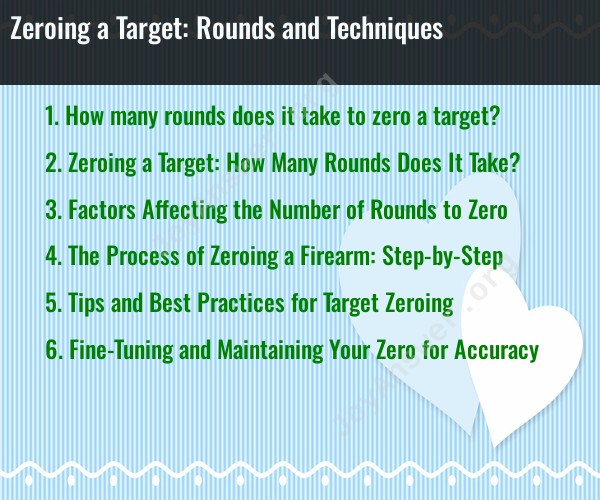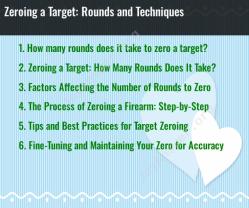How many rounds does it take to zero a target?
The number of rounds it takes to zero a target, whether it's a firearm or another type of aiming device, can vary depending on several factors, including the type of firearm, the accuracy of the initial settings, the distance to the target, and the shooter's skill. Here's a general process for zeroing a target, along with some considerations:
Initial Settings: Begin with your firearm or aiming device (e.g., a scope) mounted securely and set at its initial settings. These settings might be based on manufacturer recommendations or previous zeroing sessions.
Select the Distance: Choose the distance at which you want to zero your firearm. The most common distance for zeroing rifles is 100 yards/meters, but it can vary depending on your use case. Different distances can require different numbers of rounds to zero.
Aim at the Target: Fire a round at the center of the target. This is your initial shot.
Assess Impact: Examine where the bullet hit the target in relation to your point of aim. If it's off target, determine in which direction and by how much.
Adjust Aiming Device: Use the adjustment knobs on your scope or sights to move the point of aim in the direction needed to bring the shots to the desired point of impact. For example, if your shots are consistently hitting low and to the left, you'll need to adjust the scope in the up and right directions.
Fire More Rounds: Fire additional rounds, adjusting the aiming device between each shot based on where the previous round impacted. The goal is to bring the rounds closer to the target's center with each adjustment.
Continue Iterations: Repeat the process of firing rounds, making adjustments, and assessing impact until your shots consistently hit the target center. The number of iterations needed will depend on how far off your initial settings were and your proficiency in making accurate adjustments.
Confirm Zero: After you've achieved a satisfactory grouping of shots around the target center, fire a few more rounds to confirm that the zero is consistent. Minor adjustments may still be needed.
The number of rounds required to zero a target can vary widely. It's not uncommon for experienced shooters to zero a rifle with 10-20 rounds, but it can take more rounds if the initial settings were significantly off or if you're inexperienced with the process. Keep in mind that different firearms and sighting systems may also require different processes and rounds for zeroing.
Lastly, safety is paramount during this process. Always follow firearm safety rules, including treating every firearm as if it's loaded, keeping the firearm pointed in a safe direction, and ensuring a safe backstop for your shots. If you're new to shooting or unsure about the zeroing process, it's a good idea to seek guidance from a qualified instructor or experienced shooter.
Zeroing a Target: How Many Rounds Does It Take?
The number of rounds required to zero a target will vary depending on a number of factors, including the firearm, the ammunition, the shooter's skill, and the environmental conditions. However, it is generally recommended to fire at least three rounds to zero a target. This will help to ensure that the firearm is consistently hitting the same point of aim.
Factors Affecting the Number of Rounds to Zero
The following factors can affect the number of rounds required to zero a target:
- Firearm: The type and caliber of the firearm will affect the number of rounds required to zero. For example, a high-powered rifle may require fewer rounds to zero than a low-powered pistol.
- Ammunition: The type and weight of the ammunition will also affect the number of rounds required to zero. For example, heavy-grain bullets may require more rounds to zero than light-grain bullets.
- Shooter's skill: The shooter's skill and experience will also affect the number of rounds required to zero. A more experienced shooter may be able to zero a target with fewer rounds than a less experienced shooter.
- Environmental conditions: The environmental conditions, such as wind and temperature, can also affect the number of rounds required to zero. For example, shooting in windy conditions may require more rounds to zero than shooting in calm conditions.
The Process of Zeroing a Firearm: Step-by-Step
To zero a firearm, follow these steps:
- Choose a safe location to shoot, such as a shooting range or a private property with a safe backstop.
- Set up a target at the desired distance. For most firearms, this distance will be 100 yards.
- Boresight the firearm. This involves aligning the iron sights or scope with the bore of the barrel.
- Fire a three-shot group at the target.
- Make adjustments to the sights or scope as needed.
- Repeat steps four and five until the firearm is consistently hitting the same point of aim.
Tips and Best Practices for Target Zeroing
Here are some tips and best practices for target zeroing:
- Use a sandbag or other rest to support the firearm while shooting. This will help to improve accuracy.
- Aim at the center of the target. This will give you the most room for error.
- Fire a three-shot group at the target. This will help to ensure that the firearm is consistently hitting the same point of aim.
- Make small adjustments to the sights or scope as needed.
- Be patient. It may take several rounds to zero a firearm.
Fine-Tuning and Maintaining Your Zero for Accuracy
Once you have zeroed your firearm, it is important to fine-tune and maintain your zero for accuracy. This can be done by firing a three-shot group at the target periodically. If the firearm is not hitting the same point of aim, make small adjustments to the sights or scope as needed.
It is also important to check your zero regularly, especially if you have changed the ammunition you are using or if the environmental conditions have changed significantly.
By following these tips and best practices, you can zero your firearm and maintain accuracy for years to come.


